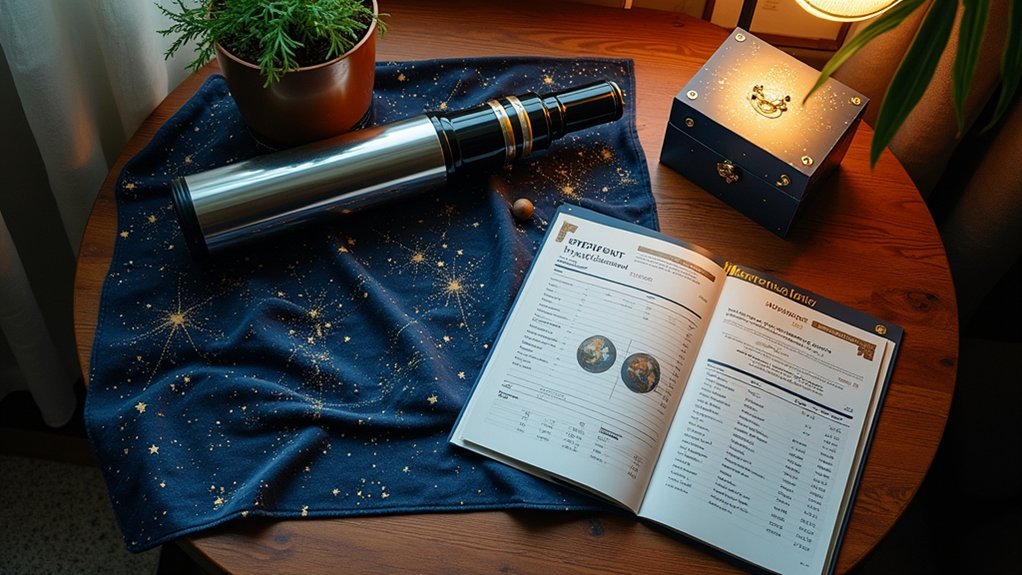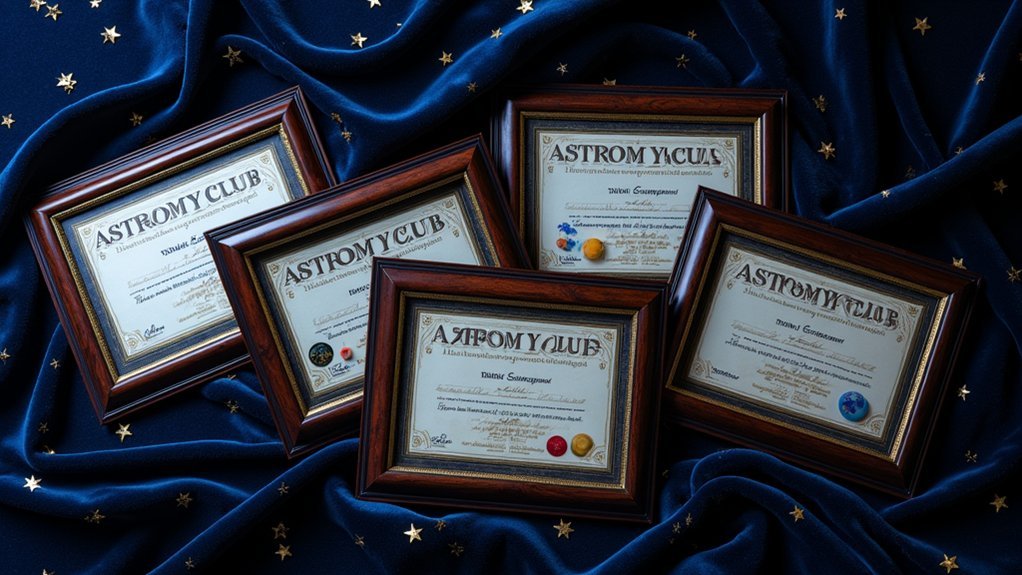Starting an astronomy club requires clear planning and vision. First, define your mission and target audience, then assemble a passionate leadership team. Secure good observation sites and meeting venues while establishing sustainable finances. Create engaging activities and develop effective marketing strategies to attract members. Build partnerships with local organizations and implement educational programs for all skill levels. Don’t forget online engagement options to keep members connected between stargazing sessions. These foundations will launch your celestial community into orbit.
10 Smart Steps To Launch An Astronomy Club

When you’re passionate about stargazing and celestial wonders, starting an astronomy club can transform your solo hobby into a thriving community experience.
Begin by defining your club’s purpose and target audience—whether you’re focusing on students, university enthusiasts, or the general public.
The foundation of any successful astronomy club lies in its mission—know your stars and your stargazers.
Establish a core committee with designated roles like Chairperson, Secretary, and Treasurer to manage operations effectively.
Create a sustainable membership structure with annual fees to cover basic costs, plus event-specific charges when necessary.
Plan diverse activities that will engage your members: star parties, guest lectures, and educational workshops build community while sharing knowledge.
Don’t forget promotion—utilize local media, social platforms, and community boards to spread the word.
The most successful astronomy clubs balance organization with the excitement of cosmic discovery.
Define Your Club’s Mission and Target Audience
Establishing your astronomy club’s mission statement will clarify your purpose and guide all future activities, whether you’re focusing on education, observation, or community outreach.
Identify your core demographics by considering who you’ll serve—beginners seeking basic knowledge, advanced amateurs pursuing technical skills, families looking for accessible experiences, or a combination of these groups.
Determine your operational scope by deciding the geographic area you’ll cover, the frequency of meetings and events, and the resources you’re prepared to commit to your club’s success.
Clarify Your Purpose
The foundation of any successful astronomy club rests on a clearly defined purpose and mission.
You’ll need to determine whether your club will focus on education, public outreach, or simply sharing a passion for celestial objects among enthusiasts.
To crystallize your purpose:
- Assess community interest levels to guarantee alignment with potential members’ expectations.
- Identify your specific audience—students, amateurs, or general public—to tailor your programs effectively.
- Set concrete goals like monthly stargazing events or educational workshops that showcase participation benefits.
- Explore collaboration opportunities with schools, universities, and community centers to expand your reach.
Your purpose statement becomes your compass, directing all club activities and helping potential members understand what they’ll gain by joining your astronomical community.
Identify Core Demographics
With your purpose defined, successful astronomy clubs must pinpoint exactly who they’ll serve. Your local club’s effectiveness depends on understanding your audience’s specific needs and interests.
| Demographic Group | Tailored Activities |
|---|---|
| K-12 Students | Interactive workshops, simple telescope nights |
| College Students | Research collaborations, advanced observations |
| Families | Weekend stargazing, kid-friendly presentations |
| Professionals | Technical talks, specialized equipment sharing |
| Seniors | Daytime lectures, accessible viewing locations |
Conduct surveys at community centers, schools, and universities to gauge interest levels before finalizing your focus. Remember that different groups require different approaches—beginners need basic guidance while experienced astronomers seek technical challenges. Consider partnering with local educational institutions to expand your reach and enhance available resources for your target demographics.
Set Operational Scope
Once you’ve identified your potential members, clearly defining your astronomy club’s operational scope becomes essential for long-term success. Your club’s mission and target audience will shape everything from meeting frequency to equipment investments.
- Draft a mission statement that addresses specific objectives—whether educational outreach, combating light pollution awareness, or advanced astrophotography.
- Match your activities to your audience’s interests and experience levels.
- Create an inventory of available resources and equipment to determine realistic programming options.
- Establish collaboration parameters with local institutions like universities or science centers to extend your reach.
Assemble a Core Leadership Team
To build your astronomy club’s foundation, you’ll need to establish essential roles including Chairperson, Secretary, and Treasurer who can guide meetings, manage communications, and oversee finances respectively.
Select founding members who demonstrate passion for astronomy and possess complementary skills that will help your club thrive in its early stages.
Create a clear governance structure with an odd-numbered committee to facilitate decision-making and develop policies that will support your club’s mission while encouraging all leaders to actively participate in setting goals and community outreach.
Defining Essential Leadership Roles
Successfully launching an astronomy club depends heavily on establishing a solid leadership foundation from the start.
You’ll need to define clear roles within your core team to guarantee smooth operations and effective decision-making.
- Appoint a Chairperson to lead meetings, set meeting agendas, and provide overall direction for the club’s activities.
- Designate a Secretary to handle communications, maintain records, and document important decisions.
- Select a Treasurer to manage finances, create budgets, and track expenditures.
- Create an odd-numbered committee (typically 3-5 members) to facilitate fair voting and balanced leadership.
Clearly defined leadership responsibilities promote accountability and ownership among team members.
Schedule regular leadership meetings to discuss club progress, upcoming events, and strategies for engaging all members in club activities.
Selecting Passionate Founding Members
The five most essential people you’ll ever recruit for your astronomy club are your founding members. Aim to gather 3-5 individuals who share genuine enthusiasm for astronomy and will actively participate in decision-making and club activities.
Your founding members should bring diverse skills to the table—look for organizational talent, outreach experience, and varying levels of astronomical knowledge. This diversity will strengthen your club’s foundation and appeal.
Assign specific roles to each founding member, such as Chairperson, Secretary, or Treasurer, establishing clear responsibilities from the start.
Encourage open communication among this core team to develop compelling activities and engagement strategies.
Leverage your founding members’ networks to promote the club through local educational institutions and community centers to attract a wider membership base.
Creating Governance Structure
Once your founding members are in place, you’ll need to formalize their roles into a proper governance structure. Establishing clear leadership positions guarantees your astronomy club operates efficiently and makes decisions effectively.
Your governance structure should be established within the first three months to maintain momentum and member engagement.
- Define key positions including Chairperson, Secretary, and Treasurer with specific responsibilities for each role.
- Aim for an odd number of committee members to prevent tied votes during decision-making processes.
- Schedule regular leadership meetings to align on goals, plan events, and address member feedback.
- Encourage your leadership team to actively participate in club activities, demonstrating commitment and building community.
This structured approach creates accountability and guarantees your club has the organizational foundation needed for long-term success.
Secure Meeting Venues and Observation Sites
Finding suitable locations for both indoor meetings and outdoor stargazing sessions represents a critical foundation for your astronomy club’s success.
Community centers and village halls make ideal meeting venues as they typically offer adequate seating, audiovisual equipment, and space for your growing membership. When evaluating potential spaces, verify they can accommodate your projected attendance and technical needs.
For observation activities, seek out dark sites away from light pollution. Local fields or cricket pitches often provide excellent stargazing conditions.
Prioritize locations with convenient parking, good accessibility, and reasonable proximity to urban areas to encourage member participation.
Don’t overlook partnerships with educational institutions that might share their observatories or planetariums.
Remember to regularly review your venues based on member feedback to verify they continue serving your club’s evolving needs.
Establish a Sustainable Financial Structure

While securing adequate venues provides the physical foundation for your astronomy club, establishing a robust financial structure guarantees its long-term viability.
You’ll need to implement a system that covers costs while remaining accessible to potential members.
- Set reasonable membership fees that cover basic operational expenses and public liability insurance, adjusting them as your club grows and needs change.
- Create a detailed budget tracking both income and expenses to regularly assess your financial health.
- Pursue local grants and funding opportunities from astronomy foundations to supplement your income for equipment purchases.
- Develop partnerships with local businesses for sponsorships that can provide additional resources or financial support.
Don’t underestimate the importance of transparency in financial matters—it builds trust and encourages continued participation from your community.
Acquire Essential Equipment and Resources
When starting your astronomy club, you’ll need to decide between telescopes, which provide detailed views of distant objects, and binoculars, which offer wider fields of view and greater portability for beginners.
You can stretch your limited budget by actively seeking donated equipment from local astronomy enthusiasts, educational institutions, or businesses willing to support STEM initiatives.
Consider organizing equipment sharing systems among members to maximize access while building your collection through targeted fundraising efforts.
Telescopes vs. Binoculars
How should you begin your celestial journey? The telescopes vs. binoculars debate hinges on your club’s goals and resources. Binoculars offer accessibility and simplicity for beginners, while telescopes provide detailed views necessary for serious astronomical pursuits.
When making your selection, consider:
- Experience level – Binoculars are more user-friendly with less setup, perfect for newcomers who might be intimidated by telescope operation.
- Budget constraints – Quality options like the Celestron Skymaster binoculars cost considerably less than entry-level telescopes.
- Observation goals – Telescopes excel at viewing distant galaxies and nebulae, while binoculars provide wider views of star clusters.
- Equipment versatility – For astrophotography, you’ll need a telescope with tracking capabilities, but binoculars are ideal for spontaneous skygazing sessions.
Seeking Donated Equipment
Where can your fledgling astronomy club acquire quality equipment without breaking the bank? Start by creating a specific needs list, then reach out strategically to potential donors who support community science initiatives.
| Source | Approach for Seeking Donated Equipment |
|---|---|
| Local Businesses | Contact directly with clear equipment requests |
| Schools | Inquire about surplus astronomy gear |
| Community Organizations | Present your club’s educational mission |
| Existing Astronomy Clubs | Ask about equipment loans or donations |
| Online Platforms | Use social media to spread your needs list |
Don’t overlook crowdfunding campaigns specifically for astronomy equipment purchases. Many enthusiasts will contribute to your cause. Remember to leverage community forums where hobbyists might donate used telescopes, binoculars, or star charts they no longer use. Collaborating with observatories can also provide temporary access to professional-grade equipment.
Create an Engaging Calendar of Activities

Why should your astronomy club settle for infrequent or impromptu gatherings when a well-planned calendar can transform your group’s experience?
Structure creates anticipation and guarantees steady participation throughout the year.
Structure breeds commitment, transforming casual stargazers into dedicated astronomy enthusiasts who mark their calendars months in advance.
Develop your astronomy program with these essential elements:
- Schedule monthly meetings featuring guest speakers, astronomical discussions, and telescope workshops to maintain consistent engagement.
- Plan stargazing nights around new moons when celestial objects are most visible.
- Incorporate special events like meteor shower viewings and public outreach programs to attract new members.
- Organize hands-on educational workshops on astrophotography and equipment maintenance.
Use online platforms to share your calendar and gather feedback from members.
This collaborative approach creates ownership and helps you fine-tune activities to match your community’s interests.
Develop Effective Marketing and Recruitment Strategies
With your stellar calendar in place, it’s time to spread the word about your astronomy club.
Create targeted social media ads on Facebook and Instagram to reach locals passionate about astronomy, potentially boosting membership by 20% within a year.
Partner with educational institutions to host free star parties and workshops, which can increase new memberships by 30%.
Design eye-catching flyers highlighting club benefits for distribution at libraries and community centers.
Engage audiences through a monthly newsletter featuring astronomy news and member contributions, aiming for a 15% email open rate.
Don’t overlook traditional channels—local radio stations and newspapers can effectively promote your events and potentially double attendance.
This multi-channel approach guarantees you’ll attract diverse members while building a recognizable presence in your community.
Build Community Partnerships and Collaborations
Successful astronomy clubs thrive by forging strategic alliances within their communities. To build community partnerships that expand your club’s reach and resources, you’ll need to work together with various local organizations.
- Connect with educational institutions – Collaborate with schools and universities to host joint events using their facilities and tap into their existing audiences.
- Partner with astronomy facilities – Team up with nearby planetariums or observatories for special programs that give your members access to professional equipment.
- Engage local libraries – Work with libraries to promote astronomy materials and host events that increase your visibility in the community.
- Network with like-minded groups – Establish relationships with other astronomy clubs and organizations like the IAU Office for Astronomy Outreach to share resources and knowledge.
Implement Educational Programs for All Skill Levels
Educational programming forms the backbone of any thriving astronomy club, providing members with structured opportunities to develop their skills and knowledge.
Design a tiered system with beginner, intermediate, and advanced courses so everyone can learn at their own pace.
Schedule monthly workshops on specialized topics like astrophotography and telescope maintenance for hands-on experience.
Even though members may have different interests, encourage them to lead presentations sharing their observations, which fosters peer-to-peer learning.
Partner with local schools and universities to create outreach programs that introduce astronomy to students.
Supplement in-person activities with online options such as webinars and virtual star parties to reach those who can’t attend meetings.
This multi-faceted approach guarantees your educational offerings engage members at every skill level.
Frequently Asked Questions
What Are the Objectives of Astronomy Club?
Your astronomy club’s objectives include promoting astronomy education, facilitating public outreach, building a supportive community, providing access to equipment, and encouraging citizen science participation. You’ll create opportunities for members to learn and collaborate.
How to Make Astronomy Interesting?
You’ll make astronomy interesting by hosting star parties, offering hands-on workshops, inviting guest speakers, using interactive tools like planetarium apps, and creating themed meetings around special celestial events like eclipses or meteor showers.
What Happened to Astronomy Club?
Astronomy clubs haven’t disappeared; they’ve evolved. You’ll find they’ve embraced virtual meetings, social media engagement, and technology integration. They’re still active but have adapted to modern challenges like light pollution and changing participation patterns.
What Is the Best Way to Start Astronomy?
To start astronomy, get a beginner’s telescope or binoculars, download a stargazing app, join local astronomy clubs, and read introductory books. You’ll learn faster when you’re observing the night sky regularly with others.
In Summary
Starting an astronomy club isn’t rocket science, but it does require planning and passion. You’ve now got the blueprint to build something special that’ll connect people with the cosmos. Remember, the best clubs evolve with their members’ interests and keep the wonder of the night sky at their core. As you move forward, you’ll create not just a club, but a community of stargazers.





Leave a Reply